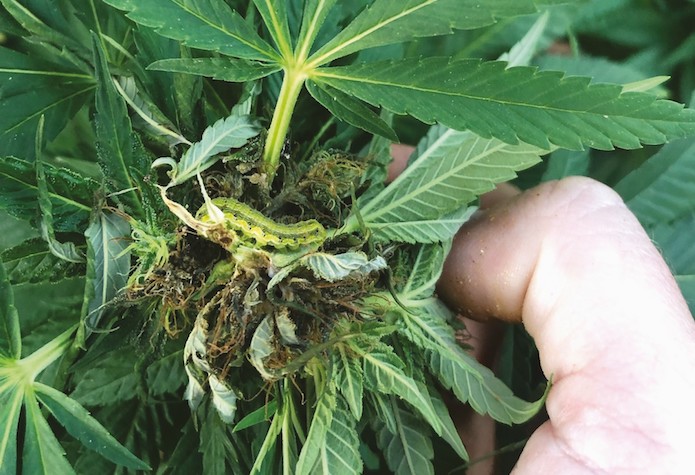
Managing Corn Earworm in Commercial Hemp Production
Cheech and Chong. The Big Lebowski. Seth Rogen. These Hollywood legends helped thrust Cannabis sativa into modern-day pop culture, making it simultaneously famous and infamous. And while the topic of C. sativa tends to elicit a range of emotions and opinions, there is no debating the fact this plant has many, many attributes and qualities.
Cannabis sativa is an annual herbaceous crop native to east Asia but is now grown worldwide and can be cultivated for a variety of purposes. Cannabis sativa is known colloquially as hemp or marijuana; these are different cultivars of the same species. The difference between hemp and marijuana is purely chemical: marijuana has a high THC (tetrahydrocannabinol, aka the intoxicating part) content, whereas the THC content in hemp, by definition, must be less than 0.3 percent. There are also some physical differences, as marijuana and hemp grown for cannabinoids have more of a bushy, horticultural crop look while hemp grown for grain or fiber appears more like a row crop, growing from a tall singular stalk.
Hemp became a legal crop with the passage of the 2018 Farm Bill (the Farm Bill is now called the Plant Protection Act, or PPA 7721). This action was significant, as it was the first time hemp was legally differentiated from marijuana. While the law placed restrictions on its production and use, the legalization of industrial hemp (as it is known) led to several pilot production programs being initiated.
Since industrial hemp had not been cultivated in the U.S. before, pest management in this new crop was an area in dire need of research. Several well-known pests present challenges to hemp cultivation, including the corn earworm (Helicoverpa zea). An article published in September in the Journal of Integrated Pest Management highlights what we do and don’t know about H. zea management in industrial hemp. I spoke with the lead author, Kadie Britt, Ph.D., postdoctoral scholar at the University of California, Riverside, about challenges and opportunities associated with this well-known corn (and now hemp) pest.
Coyle: Do you think hemp will take off? I mean, do we even have the infrastructure to support this industry?
Britt: Yes and no. There is a market, but there’s already too much planted acreage, and the market is saturated. 2019 was a big year after legalization in 2018, and some growers still have that material in their barns as of summer 2021. Hemp is very useful, and there’s a very positive long-term future with this crop in terms of grain and fiber. The fiber can be used for many things, including plastics, clothes, rope, and a bunch of other things. The grain can be used as a food (think Whole Foods fancy spices section) and has very beneficial fatty acids. Unfortunately, we still see too much cannabinoid and not enough grain or fiber acreage.
Regarding management, is it fair to say there are more questions than answers at this point?
Yes! Every answer seems to lead to more questions. Can we sample for pests in hemp as we do in other row crops? Yes, sampling is similar, but with nuances. For instance, pheromone traps don’t seem to be effective, so we’ll have to develop something else. The takeaway is that it’s difficult to rely solely on chemical control, and the best thing we can do or recommend at this point is to watch for eggs and larvae and to initiate spray applications with a product legal for use in hemp. Weekly spraying can be effective but targets only corn earworm—a more IPM-friendly approach is needed, but first we need to know more about the system.
What are the biggest management challenges for industrial hemp?
There are so many! Pest management is a huge challenge, but growers need to be able to successfully produce the crop first. Right now, there’s a lack of infrastructure for the crop as a whole. Industrial hemp is a legitimate alternative to many products; anything from fabric to plastic can be made from hemp. Some companies are building processing facilities, machinery, and all the other infrastructure necessary for a new crop. Having properly labeled pesticides available is a challenge, as industrial hemp probably won’t garner the attention of huge chemical companies, but smaller, newer biopesticide companies may be more willing, as will those that focus on specialty crops.
Any final thoughts?
Yes, the industry is new and emerging, and we have to realize that federal legalization of high-THC cannabis will likely happen at one point. The work we do now will only help prepare us for that time. Cannabis is here to stay, and pest susceptibility greatly increases when the crop is grown in a monoculture type of production. Commercial acreages are different than backyard growing operations. Any information we get now will only help future C. sativa growers, regardless of the final product.
Read more in the Journal of Integrated Pest Management.
Source: David Coyle, Ph.D., Department of Forestry and Environmental Conservation, Clemson University; Entomology Today. Photo at top: Bud rot in hemp with corn earworm present. Originally published in Journal of Integrated Pest Management, Volume 12, Issue 1, 2021, 34.



